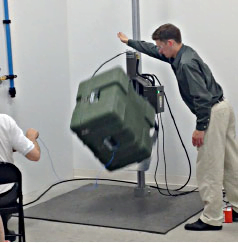Protecting Your Goods from the 3 Modes of Transportation
 When you ship a product or component, you need it to arrive intact. There are various influences that can damage or compromise your materials. These influences differ amongst the three methods of transportation: air, sea, and land. Knowing what hazards your product will be exposed to will help you understand the kind of packaging you need to protect it.
When you ship a product or component, you need it to arrive intact. There are various influences that can damage or compromise your materials. These influences differ amongst the three methods of transportation: air, sea, and land. Knowing what hazards your product will be exposed to will help you understand the kind of packaging you need to protect it.
Air
When you transport something on a plane, you need to determine how the following factors could affect your product:
Pressure – Things like acceleration, deceleration, and altitude change the pressure in a plane. Many sorts of cargo are affected by this, especially liquid cargo, as your package may be subject to developing leaks.
Turbulence – Remember: turbulence is more than bumping around. It can be a see-saw of vertical movement – dead weight and near weightlessness
Temperature – The temperature can vary significantly during flight. Additionally, cargo will be exposed to the temperature and climate during loading and unloading.
Transport space – While air freighters are adequately equipped to transport cargo, if your package is on a passenger craft, the belly of the plane will provide less protection.
Storage – Older airports don’t have designated areas for perishable or high-value cargo. If the storage area is overcrowded, your goods may be left outside and exposed to the elements, too.
Sea
Containers shipped via water will also be exposed to various handling, jostling, and space concerns similar to both air and land. The most unique threats that sea-bound packages are exposed to have to do with the elements.
Salt water and salt water vapors can cause corrosion on metal and electronic components. This is very bad for products like medical devices, computers, and any metal equipment.
Temperatures also fluctuate at sea, along with humidity. Humidity can ruin a lot of materials and create electrostatic discharge.
For sea transport, you will likely need some sort of vapor barrier protection. This is best handled through a professional packaging company. They will know exactly what kind of product works best and how to use it properly. A packager can also include a humidity indicator to test for moisture exposure, and they can offer ESD-resistant containers.
Land
No matter how your cargo travels to its destination, it is probably going to spend at least some time on a truck. This is where its exposed to the most vigorous handling. Some extra concerns involved in land transportation are:
Falling – Carriers will usually try to haul a full truck load, so your crates or packages can get stacked, subjecting them to fall or tumble around if the pile topples over.
Crushing – The weight of other cargo can be an issue, even if your package is initially placed on top of a pile. As other things are unloaded, other cargo or dunnage could come loose because of road conditions, reactive driving, or loose tie straps.
Handling – Poor or improper handling is very common when people load and unload trucks. Drivers are often on tight deadlines in the least predictable kind of traffic. They can easily feel rushed and mishandle their cargo.
Rough roads – while not as extreme as large waves or air turbulence, the roads create a very constant disturbance to cargo. Potholes and other road conditions make travel jerky and rough.
As you can see, there are a lot of variables to take into account during shipping, especially if your product is in any way fragile. Packnet’s experts can custom design a packaging solution that will both protect your goods and record damage during transit if appropriate. We have specialized protective material, like vapor barriers, ESD-resistant containers, and humidity indicators. Packnet has a full range of materials to meet your needs on both cost and protection. Contact us at 952-944-9124. You can also request a free assessment.
